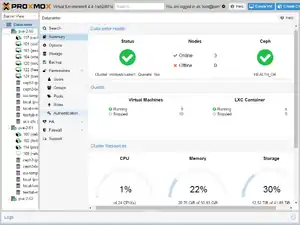Proxmox Virtual Environment
Proxmox Virtual Environment (Proxmox VE; short PVE) is an open-source server virtualization management platform. It is a Debian-based Linux distribution with a modified Ubuntu LTS kernel[3] and allows deployment and management of virtual machines and containers.[4][5] Proxmox VE includes a web console and command-line tools, and provides a REST API for third-party tools. Two types of virtualization are supported: container-based with LXC (starting from version 4.0 replacing OpenVZ used in version up to 3.4, included[6]), and full virtualization with KVM.[7] It comes with a bare-metal installer and includes a web-based management interface.[8][9]
 Proxmox VE 4.4 administration interface screenshot | |
| Developer | Proxmox Server Solutions GmbH |
|---|---|
| Written in | Perl[1] |
| OS family | Unix-like |
| Working state | Current |
| Source model | Free and open source software |
| Initial release | 15 April 2008 |
| Latest release | 6.3[2] / November 26, 2020 |
| Repository | |
| Update method | APT |
| Package manager | dpkg |
| Platforms | AMD64 |
| Kernel type | Monolithic (Linux) |
| Userland | GNU |
| Default user interface | Web Based |
| License | Affero General Public License |
| Official website | pve |
Proxmox VE is licensed under the GNU Affero General Public License, version 3.[10]
History
Development of Proxmox VE started when Dietmar Maurer and Martin Maurer, two Linux developers, found out OpenVZ had no backup tool and no management GUI. KVM was appearing at the same time in Linux, and was added shortly afterwards.[11] The first public release took place in April 2008, and the platform quickly gained traction. It was one of the few platforms providing out-of-the-box support for container and full virtualization, managed with a web-based user interface similar to commercial offerings.[12]
Features
Proxmox VE is a powerful open-source server virtualization platform to manage two virtualization technologies - KVM (Kernel-based Virtual Machine) for virtual machines and LXC for containers - with a single web-based interface.[13] It also integrates out-of-the-box-tools for configuring high availability between servers, software-defined storage, networking, and disaster recovery.[14]
KVM & Container Virtualization
Server virtualization supporting Kernel-based Virtual Machine (KVM) and container-based virtualization with Linux Containers (LXC).[14]
Storage model
Proxmox VE supports local storage with LVM group, directory and ZFS, as well as network storage types with iSCSI, Fibre Channel, NFS, GlusterFS, CEPH.[15]
High-availability cluster
Proxmox VE can be clustered across multiple server nodes.[16]
Since version 2.0, Proxmox VE offers a high availability option for clusters based on the Corosync communication stack. Individual virtual servers can be configured for high availability, using the built-in ha-manager.[17][18] If a Proxmox node becomes unavailable or fails the virtual servers can be automatically moved to another node and restarted.[19] The database- and FUSE-based Proxmox Cluster filesystem (pmxcfs) makes it possible to perform the configuration of each cluster node via the Corosync communication stack.[9]
Live migration
At least since 2012, in a HA cluster, live virtual machines can be moved from one physical host to another without downtime.[20][21] Since Proxmox VE 1.0, released 29.10.2008[22] KVM and OpenVZ live migration is supported.
Virtual appliances
Proxmox VE has pre-packaged server software appliances which can be downloaded via the GUI. It is possible to download and deploy appliances from the TurnKey Linux Virtual Appliance Library.[23][24][25]
References
- "Proxmox Manager Git Tree". Retrieved 4 March 2019.
- "Proxmox VE 6.3 with Proxmox Backup Server Integration and Ceph Octopus released". Proxmox. Proxmox. 2020-11-26. Retrieved 2020-11-28.
- "Proxmox VE Kernel - Proxmox VE". pve.proxmox.com. Retrieved 2017-05-26.
- Simon M.C. Cheng (31 October 2014). Proxmox High Availability. Packt Publishing Ltd. pp. 41–. ISBN 978-1-78398-089-5.
- Plura, Michael (July 2013). "Aus dem Nähkästchen". IX Magazin. Heise Zeitschriften Verlag. Retrieved July 20, 2015.
- "Proxmox VE 4.0 with Linux Containers (LXC) and new HA Manager released". Proxmox. 11 December 2015. Retrieved 12 December 2015.
- "Proxmox: The Ultimate Hypervisor". Ken Hess. 11 July 2011. Retrieved 17 July 2015.
- Vervloesem, Koen. "Proxmox VE 2.0 review – A virtualisation server for any situation", Linux User & Developer, 11 April 2012. Retrieved on 16 July 2015.
- Drilling, Thomas (May 2013). "Virtualization Control Room". Linux Pro Magazine. Linux New Media USA. Retrieved July 17, 2015.
- "Open Source – Proxmox VE". Proxmox Server Solutions. Retrieved 17 July 2015.
- "Proxmox VE 1.5: combining KVM and OpenVZ". Linux Weekly News. Retrieved 2015-04-10.
- "Happy 5th birthday, Proxmox". Ken Hess. ZDNet. Retrieved 2015-07-17.
- Proxmox: The Ultimate Hypervisor Proxmox employs kernel virtual machine (KVM) virtualization to support just about any operating system that you can download and install into a fully virtualized collection of hardware. And, yes, this is the same KVM that Red Hat, Inc. owns and uses as its enterprise-level virtualization solution.
- "Features". www.proxmox.com. Retrieved 2019-05-12.
- "Roadmap". Proxmox. Retrieved 2014-12-03.
- Wasim Ahmedi (2014-07-14). Mastering Proxmox. Packt Publishing Ltd. pp. 99–. ISBN 978-1-78398-083-3.
- "PVE HA Manager Source repository". Retrieved 2020-10-19.
- "Proxmox VE documentation: High Availability". Retrieved 2020-10-19.
- "High Availability Virtualization using Proxmox VE and Ceph". Jacksonville Linux Users' Group. Retrieved 2017-12-15.
- "Qemu/KVM Virtual Machines - Proxmox VE".
- "Introduction to Proxmox VE". Linuxaria. Retrieved 2014-12-03.
- "Roadmap - Proxmox VE".
- "Announcing TurnKey OpenVZ optimized builds (+ Proxmox VE channel)". Alon Swartz. 24 February 2012. Retrieved 20 July 2015.
- The Proxmox developers have released several virtual appliances, which are ready-made OpenVZ templates that can be downloaded directly from within the Proxmox web interface.
- "The next server operating system you buy will be a virtual machine". Ken Hess. 15 October 2013. Retrieved 20 July 2015.
